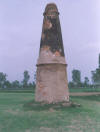|
|
the-south-asian.com November/December 2006 |
|
|||
|
Nov /
Dec Contents Real Issues Heritage
Usha
Uthup - still
Books Between
Heaven and Hell
|
|
||||
|
END OF THE ROAD FOR KOS MINARS by Mukesh Khosla
A majority of the phallic-shaped pillars built during the reign of Mughal Emperor Akbar have disappeared and a few that still exist have been vandalised and are falling apart. Now the Indian High Court has stepped in to save these important links to India’s history of highways. Motoring down from Delhi to Chandigarh or from Delhi to Agra or Jaipur many people have often popped out their heads curiously at the ancient masonry pillars every few kilometres and wondered what they are. Some think they are granaries while others say they could be night shelters. Both guesses are wrong. The phallic-shaped pillars are Kos Minars or milestones built primarily during the reign of Mughal Emperor Akbar and though they may not have any architectural merit, they have played a very important historical perspective. Such is their significance that some of the important towns and cities of north India like Faridabad, Sonipat and Karnal came up on the route marked by the Kos Minars. Centuries later North India’s modern highways have been built along these pillars. Kos was a measurement of distance during the Mughal era equivalent to three kilometres. These pillars at every Kos were on the royal route from Agra to Ajmer via Jaipur in the west and from Agra to Lahore via Delhi in the north. Besides keeping the royal entourage on track, they helped travellers reach their destinations without losing their way. According to research there were many other uses as well. There was a stepwell built around every tenth Minar that had a steady supply of cool drinking water for the weary traveller. Historians say they also served as vital communication posts. A drummer and a horse-mounted soldier were deployed at all these Minars. They delivered royal Firmans speedily, which was of great help during times of war and in peacetime these were used to spread royal decrees and orders. Now 400 years after Emperor Akbar’s death in 1605, the Kos Minars too are dying. A majority of around 1000 built during that time have disappeared and the few that still exist have been vandalised and are falling apart. Many of them have simply been encroached upon and others have been broken into and are being used as godowns. Worse, some have been repaired so shoddily that they have lost their historical character. Court Notice Seeing the plight of these 30 feet tall pillars whose network spanned over 3000 kilometres, the High Court has now issued a notice to the Delhi Government and the Archaeological Survey of India seeking their help in the preservation and upkeep of the minars. Modern-day historians attach so much significance that they say had it not been for these pillars it would have been well nigh impossible to discover the exact route of the 2600-kilometre Grand Trunk Route built in the sixteenth century by Sher Shah Suri. The road starting from Kolkata in the east, headed through Delhi to Amritsar then went on into modern-day Pakistan through to Kabul in Afghanistan. Interestingly two new National Highways---NH-2 and NH-1 from Kolkata to Delhi and from Delhi to Amritsar have been built almost on the same route as the old Grand Trunk Road on which the Kos Minars were first erected. The pitiable plight of these pillars was first noticed in 1918 during the British Raj when they were declared as ‘protected monuments’ under the Ancient Monuments Preservation Act" and restoration work was carried out periodically. But since India’s independence in 1947 most of the restoration work has been abandoned and a majority of the Minars have simply disappeared. The remaining ones are weather-beaten, vandalized and crumbling. The pressures of habitation and expansion of towns and cities are further sounding the death-knell for these forgotten symbols of the once all-conquering Mughal power. Today many of them are finding peculiar uses. One Kos Minar in Ambala has been converted into an odds-and-ends shop; in another a barber and a cobbler conduct their daily business. A residential complex has surrounded one and another one stands in the compound of a factory. Historians are already ringing alarm bells and saying that if urgent steps are not taken the once majestic Kos Minars that are such a vital link between the present and the past will forfeit all their historical significance. The pillars that once witnessed emperors go past them will be lost in the obscurity of time.
*****
|
|||||
|
Copyright © 2000 - 2006 [the-south-asian.com]. Intellectual Property. All rights reserved. |
|||||
